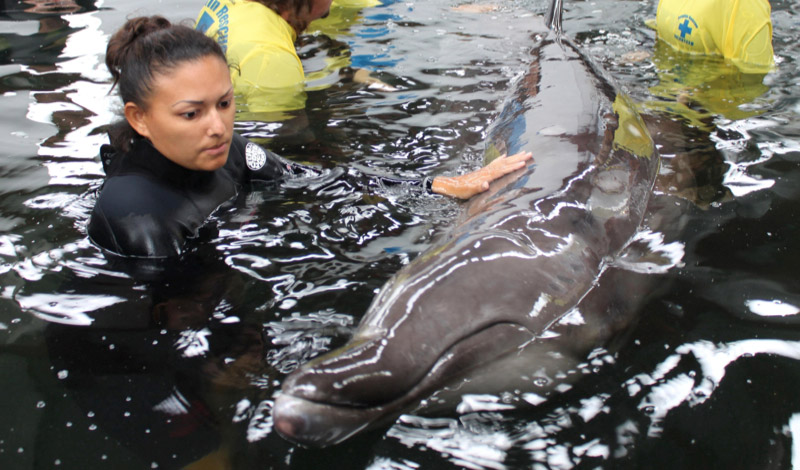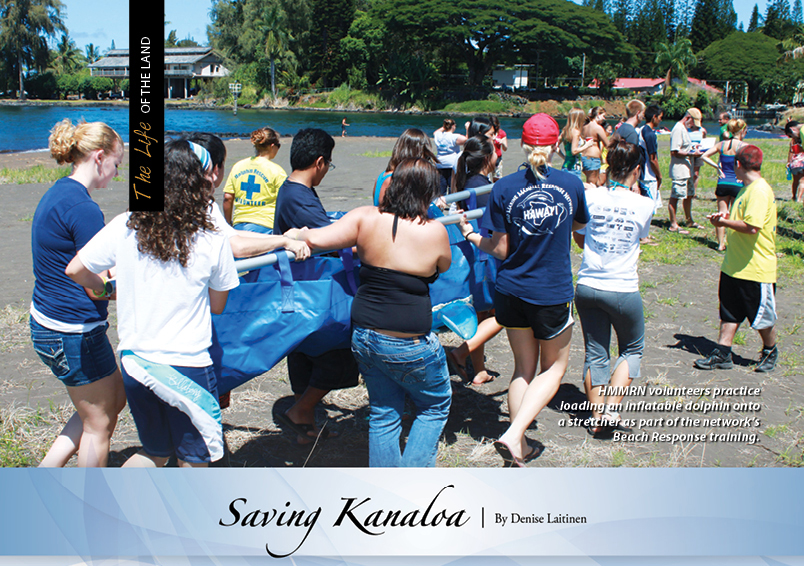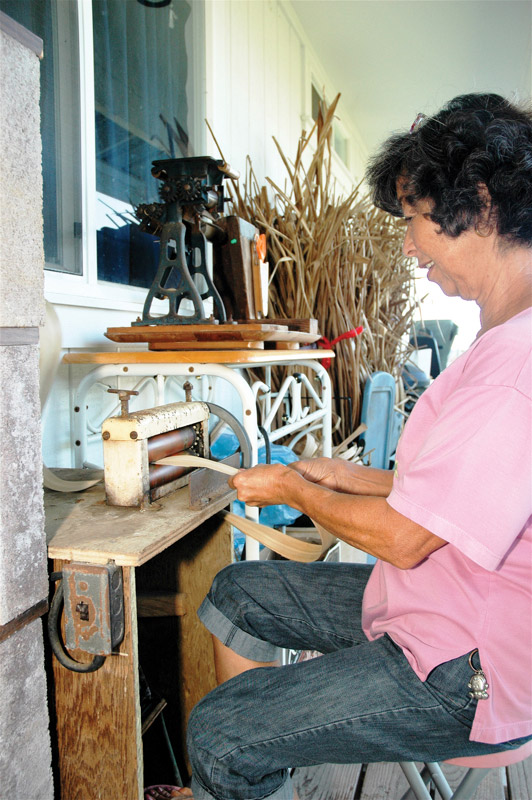
Saving Kanaloa

By Denise Laitinen
When a rare Blainesville’s beaked whale—which resembles a dolphin—stranded on Maui’s south shore last August, a volunteer alert was issued via Facebook and email. Volunteers with the Hilo Marine Mammal Response Network (HMMRN) were put on notice in the event that the whale would be brought to the only dolphin and whale rehab facility in the entire state, the Hawai‘i Cetacean Rehabilitation Facility (HCRF) in Keaukaha.
HMMRN is a volunteer-based group at University of Hawai‘i-Hilo that responds to monk seal sightings and birthings, as well as stranded and deceased marine mammals. Many of the volunteers with the Hilo Marine Mammal Response Network also volunteer at the dolphin and whale rehab facility.
With a coordinated effort between marine mammal responders on Maui, National Oceanic and Atmospheric Administration (NOAA), the Coast Guard, and the HCRF, the whale was flown to Hilo on a Coast Guard C130 aircraft.
Nearly 40 volunteers were on hand when the whale, later named “Kamaui” meaning “of Maui”, arrived at the facility. All those volunteers came in handy when it came time to lift the whale into the pool. Although HCRF has protocols for lifting an animal into the pool, the equipment is only rated up to 1,000 pounds, leaving volunteers to hand-carry the stretcher containing the 1,800-pound, 11-foot long animal off the trailer and into the pool.
When a marine mammal arrives at the facility, staff and volunteers move into high gear. Whales and dolphins at the HCRF require 24-hour care and dozens of volunteers are needed for food preparation, observing and monitoring the animal.
“The first thing we did [was] hydrate him,” says Jennifer Turner, assistant director of both the HMMRN and HCRF. Because whales get most of their fluids from their food, the whale was initially given fluids every four hours. “We gave him Pedialyte too, just like you would a kid. Once a day we added a multivitamin to it.”
Whales and dolphins usually eat fish, but beaked whales are different, causing staff to change their procedures. “We modified our plan of action to suit his needs,” says Jennifer. “It [was] specialized for him because he’s a deep diver that feeds on squid,” she adds. “He’s not a fish eater, he’s a squid eater.”
Making squid shakes was just one of the many jobs volunteers performed. Others monitored his breathing. At least two to four volunteers were in the pool with the whale around the clock.
Bob Green of Hilo was one of the volunteers in the pool. “I’ve been a diver all my life,” says Green. “It’s been my life, my passion. I’m a registered nurse, and I look at this as an extension of nursing.”
For such a rare whale to have survived stranding, an inter-island flight and transport to a rehabilitation facility sparked interest from oceanographers and marine scientists from around the world. Experts flew in from other parts of the country to help treat Kamaui.
Unfortunately, the beaked whale died two weeks after entering the facility from complications due to a combination of factors, including kidney disease, pneumonia, gastric ulcers and a severe fungal infection.
“We are the only ones in the world to have rehabbed a beaked whale for as long as we did,” says Jennifer’s husband, Dr. Jason Turner, associate professor of Marine Biology at UH Hilo and director of both HMMRN and HCRF.
That Kamaui was even given a fighting chance for recovery at a facility like HCRF is a miracle in itself. In the past, when a marine mammal stranded, it usually resulted in the animal being euthanized because there was no place to take the animal.
“It’s been a sad fact that most dolphins that stranded were euthanized,” says Jennifer. “Even five years ago there wasn’t anything.” The Turners “were active in a [stranding] network in Texas,” she adds. “And when we came to Hawai‘i we couldn’t believe there wasn’t [a rehabilitation facility].”
All that changed when the Hawai‘i Cetacean Rehabilitation Facility opened a little over a year ago. Funding for the facility, which cost $100,000, was provided by NOAA. The funding was allocated in July, 2009, and with the sweat and effort of dozens of volunteers, the facility was permitted and open by December, 2009.
A partnership developed between UH-Hilo and NOAA, the Hawai‘i Cetacean Rehabilitation Facility treats injured and sick whales and dolphins with the goal of rehabilitation or release of the cetaceans. Its area of responsibility covers all of Hawai‘i, and Samoa, Guam, and Saipan as well.
It currently includes an office and food prep kitchen for the whales and dolphins, as well as a 27,000-gallon Critical Care Pool. Staffed with volunteers from the Hilo Marine Mammal Response Network, the facility is authorized to house 18 different species of whales and dolphins up to 15 feet in length.
Currently, it can accommodate one to two small whales or dolphins at a time. Plans are in place for phase two, including a larger pool to accommodate larger whales and a swim-out pool for animals to begin diving and feeding on live fish before they are released back to the ocean.
Yet few in the Hilo community realize that they have such a rare and significant facility in their backyard. HCRF is uncommon because it is the only facility of its kind in the entire state. Indeed, there are few dolphin and whale rehabilitation facilities in the country. Nationwide, only two dozen facilities are set up to rehabilitate marine mammals, and only half of those handle whales and dolphins.
UH-Hilo has the distinction of being one of only three universities in the entire country with a dolphin rehabilitation program. “I’m very proud to say that we represent one of three University-based whale and dolphin rehabilitation facilities in the United States,” says Dr. Turner. “That’s a nice designation for UHH and for Hilo.”
Dr. Turner is quite clear that the facility is one of transition and is not meant for long-term care of marine mammals. “The HCRF developed a set of stranding protocols that define the acceptance criteria for animals into the facility,” he explains. “We cannot keep animals indefinitely, due to our permitting and the costs involved. We’re a hospital and are here to get animals healthy and back out into the ocean.”
Even the name of the facility, Poolamau, reflects this transition phase. In Hawaiian, Poolamau refers to “the transition of the animals returning to the ocean or passing to the next world.”
A defined plan is developed for every animal brought to the facility. Optimally, the animal is restored to health and released. If NOAA determines that the whale or dolphin is non-releasable, it’s transitioned to captive care at another facility. A sad fact of life is that sometimes the animals die before they can be released back to the ocean.
Yet it’s important to try to save the marine mammals that strand. “Stranding networks were not initially formed to save dolphins from the natural process of life and death,” says Dr. Turner. “They were formed as we started to realize that our negative impacts upon the world’s oceans were killing these animals. We’ve learned over the years that whales and dolphins are important ocean sentinels, meaning that they often eat the same things we eat, and are susceptible to the same toxins and diseases that we are.”
In Hawai‘i, whales and dolphins take on extra significance because they are considered Kanaloa, or ocean deities in Hawaiian culture.
The HCRF is unique in that it is the only cetacean rehabilitation facility in the country that incorporates cultural practices in its operating procedures. “We’re the only facility in the country working with cultural practitioners to mesh together stranding protocols with cultural practices, in this case native Hawaiian cultural practices,” explains Dr. Turner.
Cultural Practices is one of the five required classes volunteers need to take in order to work in the pool with the whales and dolphins. Cultural Practitioner Roxanne Stewart, who works at the Ke Ana La’ahana School in Keaukaha, teaches HMMRN volunteers about various Hawaiian cultural concepts, such as the importance of kupuna and Kanaloa. Volunteers also learn about pō, the realm of the gods, and kino lau, other forms an entity may take. These concepts are all contained in the Kumulipo, a Hawaiian creation chant, 2,000 lines long, that recites the origin of the
Hawaiian people.
“We’re not teaching our volunteers to be practitioners,” explains Stewart, who also holds bachelor and master degrees in the marine sciences field. “We’re trying to broaden their understanding of the native Hawaiian connection to the natural environment as we understand it through the Kumulipo and other resources that have been left to us in the form of chants and other traditions.”
While Kamaui’s transition was that of its passing away, Dr. Turner knows that marine mammals can strand at any time and at any place, and a well-trained response team can save lives.
Thus, a few months after the beaked whale’s journey to HCRF, Dr. Jason and Jennifer Turner spent one Saturday afternoon training new volunteers in Beach Response and Animal Transport. On a hot and sunny fall afternoon, a few dozen people gathered on the beach along Hilo Bayfront with large inflatable dolphins and blue plastic canvas stretchers.
“Beach response training gives volunteers the skills to respond to stranded whales and dolphins and also educates the public on stranding response,” says Jason Turner. “Almost every dolphin stranding case in Hawai‘i has involved members of the public pushing these sick or injured animals back out to sea, not knowing the harm they are doing.”
The two courses are part of the five training sessions volunteers need to take in order to work with marine mammals at HCRF. The other three trainings include Daily Operations (of the dolphin rehabilitation facility), Animal Care, and Cultural Practices. The trainings are usually held on Saturdays and offered about once a semester. They’re bundled together, so volunteers can complete all five courses in about two Saturdays. At least 80 of the roughly 250 volunteers with the Hilo Marine Mammal Stranding Network have gone through the five training sessions to be volunteers at HCRF.
“Volunteers are the driving force behind the HCRF and we could not do this important work without them,” says Dr. Turner.
The trainings are also essential because marine mammals are protected by federal law. HMMRN, which is permitted through the National Oceanic and Atmospheric Administration (NOAA) and the Division and Land and Natural Resources Division of Aquatic Resources (DAR), responds to stranding events under NOAA’s authorization. Therefore, it’s vital the volunteers know the proper procedures to follow.
And the practice comes in handy because no one knows when or where a marine mammal might strand and need a helping hand.
Marine mammals are protected by the Marine Mammal Act of 1972. This federal law makes it illegal for unauthorized persons to touch, harass, or prompt the animal in any way to change its natural behavior. Violating this law will earn you fines of $10,000. Remember that these are wild animals and touching and/or harassing them is very stressful to them.
If you encounter a sick/injured marine mammal:
- DO NOT touch it or feed it!
- Call the Hilo Marine Mammal Response Hotline at 808.756.5961 and provide as much information as possible, including its location and the condition of the animal.
- DO NOT push the animal back into the water. They have stranded for a reason and will probably restrand if returned to the water.
- Observe the animal from at least 50 feet away and keep pets away from them.
For more information or to volunteer:
HMMRN and HCRF need volunteers for a variety of functions from fundraising to public education to construction and much more. Both groups are on Facebook. HMMRN also holds monthly meetings the first Tuesday of every month at 6 p.m. at the Marine Science Building, Room 101, on the UH Hilo Campus.
For more information, to donate, or to volunteer with the Hilo Marine Mammal Response Network. For more information or to donate to the Hawaii Cetacean Rehabilitation Facility.
Photos courtesy of Hawaii Cetacean Rehabilitation Facility


